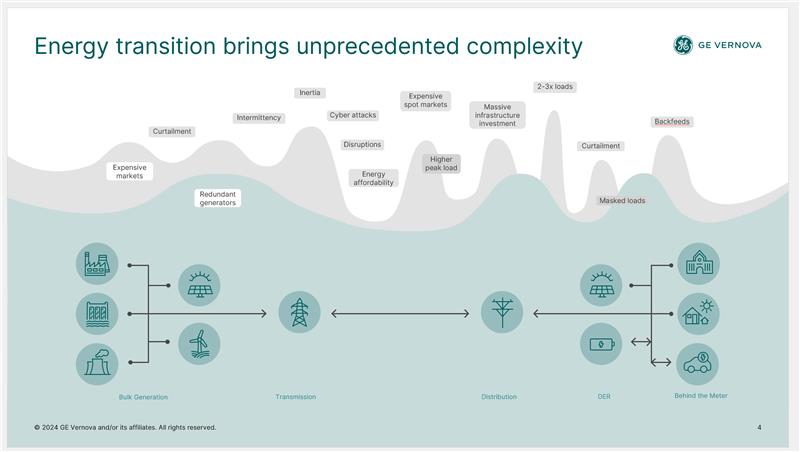You might not think a purring power grid and a fountain of French fizz have much in common, but Thorsten Heller, the chief innovation officer at GE Vernova’s Grid Software business, begs to differ. He compares an efficient network for electricity delivery to the champagne towers popular at weddings, where the sparkling wine overflowing from the coupe at the summit trickles down evenly into tiers of glasses below, without ever spilling a drop.
“This orchestration is a great trick, but it only works if you have the ‘data’ on every level,” he says, referring to the precise science of arranging and pouring the glasses. The slightest miscalculation will lead to uneven champagne distribution, or even the odd leak. If the errors are larger, the trick will fall as flat as a bottle of bubbly left out in the midday sun.
The same principle applies to the modern power grid, although the precious commodity flowing through the network isn’t champagne, but megawatt-hours of electrons. And the network’s “nodes,” as Heller calls them, aren’t pyramids of saucer-shaped glasses, but millions of new power-producing and -consuming assets, such as the giant batteries connected to an onshore wind farm, the electric vehicle (EV) charging points at the local mall, and the solar panels on someone’s rooftop.
These two-way nodes are vital to accelerating the global energy transition to a low-carbon economy, but they’ve also turned the job of maintaining grid stability, flexibility, and efficiency into a Herculean challenge for the world’s utilities. “All of these nodes are also producing and consuming valuable data, which needs to be processed to turn insight into action,” says Heller. “That is exactly the big challenge that we at GE Vernova are working to solve.”
And they’ve produced a solution. GE Vernova is unlocking the power of the data that is being churned out across the grid ecosystem, from the total availability of a country’s gas-fired turbine fleet to the exact wind speed that will turn the blades of an onshore wind farm to the average power consumption of EV drivers in a specific district. It’s about to launch GridOS Data Fabric, an integrative architecture that allows a utility to weave together the multiple strands of information in the grid’s data-rich universe into a unified view capable of spanning transmission, distribution, and the edge. “It allows utilities to discover, govern, and utilize the highly distributed data that is increasingly critical for grid orchestration,” says Sean Moser, the senior vice president of product management for GE Vernova’s Grid Software business. GE Vernova is now preparing to roll out GridOS Data Fabric on its GridOS platform, which is helping utilities orchestrate the complexity of a more sustainable energy grid.
“Energy data plays a key role in delivering a more efficient grid,” says Mahesh Sudhakaran, the general manager of GE Vernova’s Grid Software business. “But leveraging the breadth and depth of data today requires utilities to have interconnectivity, security, and intelligent software integrations that make grid orchestration possible at scale, across transmission, distribution, and endpoints along the grid. Energy data will power AI and machine learning (ML) technologies that allow utilities to move at speed to meet demand while addressing renewables management and electrification challenges.”
Success in that mission is not just good for a utility’s bottom line, but a boon for consumers and the planet. An efficient, well-orchestrated network helps keep a lid on wholesale power prices, lowering household energy bills. But it also enables and enhances the participation of consumers in the energy transition, thereby accelerating it. “As consumers, we need to be part of the energy transition,” says Moser.
The Grid’s Changing Face
Grid management used to be straightforward. Until a few years ago, the typical grid consisted of an array of major power plants, a bevy of electrical substations to step voltage up or down, a transmission network to ferry power long distances, and a distribution system, which relayed the electricity to end consumers. “Utilities just needed to look at their assets and think ‘How’s it doing? Is it behaving well?’” says Moser.
Their assets were usually docile creatures. If their power plants were generating, utilities rarely had to micromanage their transmission and distribution networks. “They were very predictable: You knew for the most part that tomorrow was going to look like today, and this February would look like last February,” says Moser.

Then came the era of renewables and greater electrification, which has transformed the grid as we know it. Countries are now adding hundreds of gigawatts of wind and solar generation every year. Households have adopted their own small-scale generation assets, such as rooftop solar panels, and replaced their gas-fueled cars and gas-fired boilers with EVs and heat pumps. As they do so, they are permanently changing the profile of our electricity networks. For example, in the European Union and Brazil, the growth in rooftop solar generation capacity is expected to outpace large-scale plants. “Everyone now has the ability to be a mini generator, with spiky, highly variable demand,” says Moser.
The job of predicting supply and demand has changed from being a low-risk, educated guess into a high-stakes, real-time science. “If I’m a utility, I’ve got a million new things in my patch, many of which I don’t own or know,” says Moser. These new grid nodes all come with their own ecosystem of supply-and-demand dynamics, creating billions of new variables. “I now have to predict whether a cloud passed over an individual house, or whether there was a gust of wind in a certain place,” he adds.
These are not hypothetical scenarios, but current reality. Sudden cloud cover in Australia can cause steep drops in rooftop solar generation, which can cause frequency glitches on the country’s transmission grid. Healthy wind in the Netherlands sounds like good news, but an unmanageable peak in total renewable generation might cause the grid operator to ask the distributor to curtail distributed energy production. The power grid in the state of Texas, which suffered blackouts in February 2021, recently beefed up the ability of its network to orchestrate data and manage load.
Sudhakaran is urging prompt action. “If we don’t make changes soon, the grid will become a bottleneck that blocks, rather than enables, the energy transition,” he wrote in a LinkedIn post published last year.
The Data Mountain
As with our champagne tower, it’s a long path to perfect orchestration. It doesn’t help that the energy industry wasn’t required to undergo digital transformation at the same rate as other major business sectors. But the sector is getting into its stride, says Moser. “Data is the very first mountain to climb, and it’s quite frankly the hardest one,” he explains. After summitting, it’s much easier going, he adds. “You can then traverse every other mountain in front of you.”
Given the nature of the grueling ascent, the hardy sherpas who should lead the sector upward are not necessarily energy experts, but data gurus. “You need people who have seen digital transformation in other places and know that the data problem is the first and hardest,” adds Moser.
This is exactly how GE Vernova has approached the grid orchestration problem. They turned to data scientists whose north star wasn’t energy security, reliability, or affordability, but empirical logic: that is, they know that improvement begins by gathering and analyzing data, and reams of it. “They gathered data on a scale that wasn’t incremental — we’re talking orders of magnitude more,” says Moser.
For example, GridOS Data Fabric can help utilities leverage traditional data sources such as the typical load curve from a country’s grid operator, which offers a baseline view of demand on a transmission or distribution network. But it doesn’t stop there. Depending on the user, it enables them to blend in “open source” data about national EV ownership and traffic patterns from a transport ministry to build up a more accurate picture of weekly consumption. (Users could drill down even further, correlating that information with IT data about customers, and pinpoint where those EVs live.) For a real-time picture of a local distribution network, utilities might harness minute-by-minute weather data, small-scale renewable generation availability, and the historical consumption patterns of a district’s EV users.
As they built GridOS Data Fabric, GE Vernova’s team abided by another principle: open data. “This old model of monolithic silos of [enterprise] data is absolutely antithetical to solving the data problem,” says Moser. “Sharing information and allowing these systems to interoperate is the only thing that will allow the energy transition to occur.”
But GE Vernova’s engineers and scientists aimed higher than a centralized repository of unstructured data. “It has to be massive, but it also has to be federated,” says Heller, using the term for a system that maps multiple autonomous databases into one. Bingo: a grid fabric. “We’re weaving important functionality into this fabric: the semantic layers to access the data, the tools to harmonize it, and the support to govern it,” he says.
Spurring the Transition
Part of this support is the use of artificial intelligence to generate meaningful insights from the data fabric, allowing for the optimization of the grid all the way from the power plant to the light switch. “The algorithms can do multiple calculations and computational problem-solving, which make sure that when you turn on the lights, they come on with minimal waste,” says Moser.
The platform can improve the efficiency of any grid, but its sweet spot would be networks where there are renewables buildout and electrification is increasing rapidly, such as the grids in the western United States, Northern Europe, and the east coast of Australia. There’s also plenty of potential in Asia and Africa, where grids are rapidly adding distributed generation capacity, rather than slowly transitioning from traditional setups, says Moser.
Delays to grid orchestration can disenfranchise end consumers, which will put the brakes on the energy transition. “The utility will need to impose constraints if they can’t manage the data,” says Moser, describing a dispiriting scenario. “They won’t be able to let you put a solar panel on your roof, or plug in your car in the garage.”
Moser’s constraints scenario is exactly what GridOS Data Fabric has been designed to avoid. “As consumers, we only used to worry about our energy consumption,” says Moser. “Now we’re a vital part of the generation that can drive the energy transition.”
